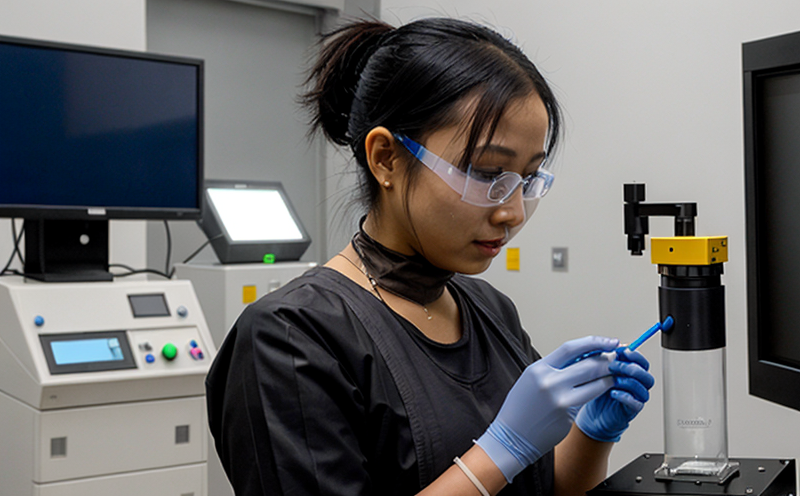ISO 16000 37 Indoor Air Testing of Nanoparticles Released from Products
The ISO 16000-37 standard is a critical tool for ensuring that products designed to be used indoors do not inadvertently release nanoparticles into the air, which could pose health risks. This service involves testing indoor environments to ensure compliance with this international standard.
Indoor air quality (IAQ) is an essential concern in various sectors such as construction, furniture manufacturing, and electronics production. Nanoparticles can be released from these products during use, and their accumulation indoors can lead to adverse health effects for building occupants. Compliance with ISO 16000-37 helps manufacturers design safe products by identifying potential sources of nanoparticle emissions.
The testing process begins with the selection of appropriate sampling locations within a specified indoor space. The chosen areas should represent typical usage scenarios and be free from external contamination. Once identified, these locations are monitored for nanoparticle concentrations using specialized air samplers capable of capturing ultrafine particles down to 0.01 microns in diameter.
Sampling duration is typically determined by the expected particle release rate and desired precision levels. For instance, longer sampling times may be necessary when dealing with low-emission materials or highly sensitive analytical methods. After collection, samples are analyzed using advanced techniques such as scanning electron microscopy (SEM) coupled with energy-dispersive X-ray spectroscopy (EDX), transmission electron microscopy (TEM), and atomic force microscopy (AFM).
These instruments provide detailed information about the size distribution, morphology, and elemental composition of detected nanoparticles. This data is then compared against predefined thresholds outlined in ISO 16000-37 to determine whether the tested product complies with the standard.
Compliance with ISO 16000-37 not only protects public health but also enhances brand reputation by demonstrating a commitment to responsible manufacturing practices. Additionally, it enables manufacturers to meet regulatory requirements set forth by governmental bodies around the world. By adhering to this international standard, companies can gain competitive advantages in both domestic and international markets.
Understanding the significance of ISO 16000-37 requires an appreciation for its role in safeguarding indoor air quality across diverse industries. From office buildings to residential homes, maintaining clean air is paramount. The standard provides a standardized approach for measuring nanoparticle emissions from various products used indoors, ensuring consistent and accurate results.
Furthermore, ISO 16000-37 helps identify potential hazards associated with nanoparticles released into the environment. By understanding these risks early in the product development process, manufacturers can take proactive steps to minimize them. This foresight contributes significantly to creating safer environments for all individuals who interact with their products.
In conclusion, ISO 16000-37 plays a vital role in promoting safe and responsible manufacturing practices within the nanotechnology sector. Its application ensures that indoor air remains free from harmful nanoparticles, fostering healthier living conditions for everyone involved.
Applied Standards
The ISO 16000-37 standard is part of a larger series dedicated to evaluating various aspects of indoor air quality. Specifically, this particular part focuses on the measurement and characterization of nanoparticles released from products into indoor environments.
- ISO 16000-1: General principles for indoor environmental quality assessment.
- ISO 16000-4: Determination of particle size distribution in indoor air.
- ISO 16000-37: Measurement and characterization of nanoparticles released from products into indoor air.
These standards work together to provide a comprehensive framework for assessing the impact of nanomaterials on indoor air quality. By adhering to these guidelines, manufacturers can ensure that their products meet stringent quality control measures while minimizing any adverse effects on human health and safety.
Scope and Methodology
The scope of ISO 16000-37 is broad, encompassing the evaluation of nanoparticles released from various types of products into indoor air. This includes but is not limited to textiles, coatings, adhesives, paints, and electronic devices.
The methodology involves several key steps:
- Identification of potential sources of nanoparticle emissions within the product design.
- Determination of appropriate sampling locations based on expected usage patterns and environmental conditions.
- Capture of air samples using high-efficiency particulate air (HEPA) filters or equivalent devices capable of capturing nanoparticles down to 0.01 microns in diameter.
- Analysis of captured particles using advanced microscopy techniques such as SEM, TEM, and AFM.
The results obtained from these analyses are compared against predefined limits established by ISO 16000-37 to determine compliance status. Compliance ensures that the tested product does not release excessive amounts of nanoparticles into indoor air environments.
Use Cases and Application Examples
- Textiles: Testing for nanoparticle emissions from clothing, bedding, or upholstery materials.
- Coatings: Evaluating paint, varnish, or sealant products to ensure they do not release harmful nanoparticles into indoor air.
- Adhesives and Sealants: Assessing the potential for nanoparticle emissions from glues or caulking compounds used in construction projects.
- Electronics: Monitoring the release of nanoparticles from consumer electronics such as televisions, computers, or mobile devices during normal usage.
In each case, compliance with ISO 16000-37 ensures that products meet strict quality control measures while minimizing any adverse effects on human health and safety. This standard is particularly beneficial for manufacturers who aim to produce safe and reliable products suitable for indoor use.





